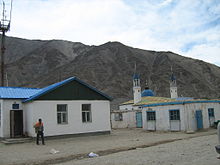Religions in Mongolia
Among the religions in Mongolia is Shamanism is the oldest and z. Some of the forms still practiced today, with Tengrism initially developing. Since the borders of Mongolia have changed again and again in the course of history, a clear assignment is not always possible, so that there are overlaps with other countries. The figure of the sky god Tengri was also common among many neighboring peoples. There is evidence of this in Chinese literature since the 4th century BC. u. Z. A creed written in Orkhon runes can be found around a thousand years later in the 7th century. However, Buddhism has established itself as a formative religion in Mongolia over the course of around 2000 years.
Buddhism
Through the Xiongnu , Buddhism came to the country very early. Genghis Khan , who united the Mongolian tribes from 1190, was opposed to Buddhism, which according to the traditional view has been since the 1st century a. Z. had spread in China, very tolerant, so that this new religion was able to establish itself in the following period. His grandchildren used Buddhism to expand the Mongol Empire , which at times comprised large parts of China . Kublai Khan , who ascended the Mongol-Chinese imperial throne in the middle of the 13th century, promoted the Tibetan clergy. According to reports, there were already Christians and Muslims in Mongolia. The Flemish Franciscan Wilhelm von Rubruk wrote about his visit in 1254 in the then capital Karakorum : "There are also twelve idol temples and two mosques, as well as a Nestorian Christian church at the far end of the city."
Altan Khan supported Gelug , one of the main schools of Buddhism , in the 16th century . In 1578 the title of Dalai Lama was bestowed on the then leader of the Gelug. Since then, shamanism has been increasingly suppressed and many of its symbols have been burned. In 1586 the Buddhist monastery Erdene Dsuu was built near Karakoram. In the 17th century, Tibet was the religious center of Lamaism , which in Mongolia had initially become the predominant religion and eventually the state religion . The monasteries were controlled from Tibet. One problem, however, was the distance and accessibility of Tibet. This finally led to the institution of a relatively independent Mongolian Hutuktu from 1640, whose tradition is still maintained today.
20th century
At the beginning of the 20th century, the Buddhist monasteries had great economic power and essentially determined life in Mongolian society: More than half of the men worked as monks or lay people in the more than 800 monasteries. It was at this time that the first Christian missionaries came to the country. Although there was already a Nestorian church in the old Mongolian capital Karakorum around 1250 , this religious denomination was practiced by only a tiny minority. In 1922 Mongolia was declared a Mission sui juris by the Roman Catholic Church .
Until 1912, the Jebtsundamba Khutukhtu (Hutuktu), the spiritual head of Buddhism in Mongolia, had to be confirmed by the Chinese emperor. In contrast, Bogd Khan , the 8th Jebtsundamba Khutukhtu, sought support from Russia to realize his dream of an independent theocratic Mongolian empire. In doing so, however, he broke many religious traditions such as the monk's vows. These efforts for independence were supported by other European states and initially also after the revolution by Russia, so that Bogd Khan was able to remain in office until his death - if only symbolically in the end - on May 20, 1924. At the same time, the Soviet leaders fought religion, with the signs of decline from the time of Bogd Khan accommodating them. While Joseph Stalin was in office in the friendly Soviet Union , there were also measures against religious activities in Mongolia. Monasteries and temples were destroyed, including Erdene Dsuu in 1937. However, the Buddhist burial was tolerated.

Since democratization in 1991, religions have been able to develop more freely again, to which Islam and Christianity now also belong. Bogd Khan's successor can appear publicly as the 9th Bogd Gegen, and the majority of the population professes Buddhism today, with Lamaism still being the dominant trend. In 2007 there were around 100 Buddhist temples and monasteries and in 2010 there were more than 40 mosques. Shamanic and similar ethnic religions are practiced by around 19 percent of the population, according to a data collection from 2010.
Individual evidence
- ^ A b Mongolia - Religious Adherents . Association of Religion Data Archives, accessed November 28, 2017.
- ↑ Robert Bleichsteiner : The yellow church. Mysteries of Buddhist monasteries in India, Tibet, Mongolia and China; Belf Verlag, 1937, p. 21f.
- ^ Markus Porsche-Ludwig, Jürgen Bellers: Religion in Mongolia; 2013 (Traugott Bautz)
- ↑ Michael Weiers: The Mongols. Contributions to their history and culture. Scientific Book Society Darmstadt, 1986, p. 416.
- ↑ Ivan Yakovlevich Korostovetz: From Chinggis Khan with the Soviet Republic. A brief history of Mongolia with a special focus on the most recent times. Walter de Gruyter 1926, p. 51.
- ^ Marion Wisotzki, Ernst von Waldenfels, Erna Käppeli; Mongolia. History; 2015 (Trescher)
- ↑ Timothy Michael May: Culture and Customs of Mongolia. Westport 2009, pp. 46-55


